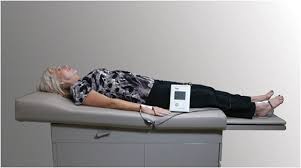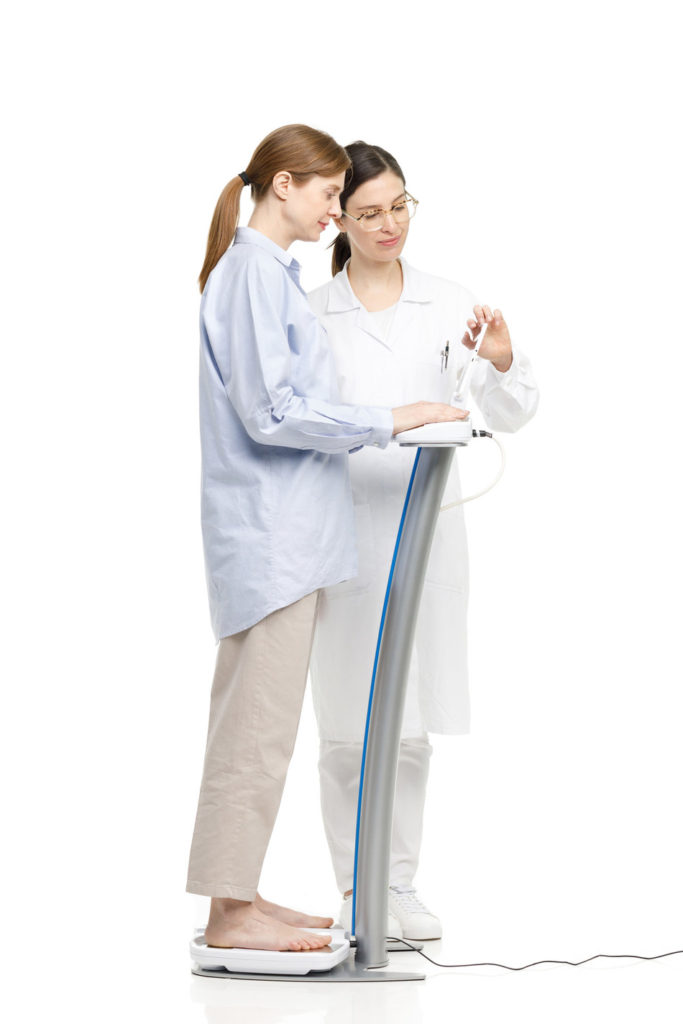Chronic primary or secondary lymphedema is a progressive condition, which cannot simply be described as an accumulation of protein-rich fluid as a result of inadequate lymphatic drainage. It is a chronic degenerative and inflammatory process affecting the soft tissues, skin, lymph vessels and lymph nodes, often resulting in severe and disabling swelling. It may present in the extremities, trunk, abdomen, head and neck and external genitalia, and can develop anytime during the course of a lifetime in primary cases; secondary cases may occur immediately following the surgical procedure or trauma, within a few months, a couple of years, or twenty years or more after treatment.
When lymphedema is present, lymph, as well as other fluids accumulate in the space between the cells in the tissues (interstitial spaces), resulting in an overall increase in the amount or extracellular fluid (ECF) in the affected area, which is the cause for the swelling.
Once present, lymphedema progresses through stages, and treatment intervention in early stages has been shown to result in very good outcomes if managed appropriately. Early detection is therefore paramount in order to avoid the progression of lymphedema.
Bioimpedance spectroscopy (BIS) is an effective tool to detect lymphedema early (stage 0 and stage I) in unilateral, as well as bilateral arms and legs, and assists healthcare professionals to identify at-risk patients early. Due to the capability of BIS to aid in the assessment of sub-clinical lymphedema, it can potentially reduce the rate of progression to chronic lymphedema and trigger early and effective treatment intervention. Compared to other screening tools, such as circumferential tape measurements (TM), which leave room for human error, BIS is more patient-friendly and provides quicker and more accurate data.
Results from the PREVENT study(4) demonstrated that only 7.9% of individuals who were assessed using BIS developed chronic lymphedema using a short-course compression intervention, compared to 19.2% of patients who developed chronic lymphedema using traditional TM methods. Lymphedema in its subclinical (latent) stage is characterized by accumulation of tissue fluid, which is not yet visible. Diagnosis in this early stage (defined as greater or equal to 10% volume change from baseline) is uncommon; BIS technology is able to recognize changes in fluid accumulation at this stage, and can significantly improve patient outcomes if compression intervention is applied after early lymphedema diagnosis.
ImpediMed, an Australian company pioneered the use of BIS technology and produced the first BIS devices in the early 1990’s.

L-Dex® U400 by ImpediMed
BIS measurements have traditionally been performed using devices with gel-backed adhesive electrodes with the patient laying supine on a flat surface. In recent years, these devices were discontinued (many are still successfully in use, i.e. the L-Dex® U-400), and impedance devices with the patient in a standing position using stainless steel electrodes (SOZO®), have become available.
How does BIS for the assessment of lymphedema work?
Bioimpedance measurements are taken by sending a harmless, painless low-frequency electrical current through the body fluids and measuring the body’s resistance (or impedance) to this electrical current. The resistance of the body fluids to the electrical current is inverse proportion to the volume of extracellular fluid, which means that the higher the volume, the lower the resistance. As lymphedema develops, the amount of fluid will increase, making it easier for the signal to travel though the extracellular fluid of the body.

SOZO® Device by ImpediMed
In the clinical setting, the BIS device measures the resistance of the unaffected limb and compares the result to the resistance of the affected, or at-risk limb, which is expressed as the “impedance ratio”, or the L-Dex score. The L-Dex score represents the difference in the amount of extracellular fluid in an at-risk limb compared to an unaffected limb. At-risk patients receive a baseline measurement before treatment and are then measured regularly after treatment; subsequent L-Dex scores are then compared to their baseline for an individualized assessment.
An L-Dex unit change of 6.5 from baseline suggests that sub-clinical lymphedema is present, and an L-Dex unit change of 7.0 or more from baseline is an indication that clinical lymphedema is present (1), and that the patient should be referred to a certified lymphedema therapist for Complete Decongestive Therapy (CDT). In general, it can be said that the higher the L-Dex score, the more severe the symptoms of lymphedema.
CDT as the standard of care for the treatment and management of clinical, symptomatic lymphedema is well established; adjunct treatment modalities include intermittent pneumatic compression and surgical options, such as suction assisted protein lipectomy (SAPL), or reconstructive surgeries .
A lymphedema diagnosis in the chronic stage, where secondary changes are present (fibrosis, sclerosis, infections, joint problems, etc.) requires more or less intensive treatment interventions and lifelong maintenance. Early detection and treatment of lymphedema in the sub-clinical stage may prevent progression of this condition and could offer less extensive avenues of conservative treatment options.
In sub-clinical lymphedema (also labeled as latent, or stage 0 lymphedema) the transport capacity of the lymphatic system is reduced, but the remaining lymph vessels are sufficient to manage the flow of lymph, and swelling is not visibly present. In this stage patients may experience early symptoms, such as the feeling of numbness, tingling or fullness in a limb, which is often accompanied by low-grade discomfort. It may be difficult to fit into clothing, and watches, rings or bracelets may feel tight. This sub-clinical stage can exist for months, or years, before any more serious signs appear. The onset of lymphedema correlates to the ability of the lymphatic system to compensate for the reduced transport capacity of the lymphatic system, and any added stress to the system that may cause an increase in the volume of lymphatic fluid.
Treatment intervention in early stages has been shown to result in very good treatment outcomes using simple, low-grade compression garments. Studies suggest that a potential intervention using compression garments as a single treatment measure over a relatively short duration can reduce measurements to baseline and maintain limb volume, thus possibly preventing the need for CDT(2).
Research suggest that BIS is an appropriate approach to assess, monitor and diagnose lymphedema. This screening method may open the door to a possible new standard of care for individuals affected by arm or leg lymphedema, where patients can be measured frequently and the physician is able to assess the patients’ lymphedema status instantly without the need for more expensive diagnostic tests, such as lymphscintigraphy, and manage treatment appropriately. Research demonstrated that development of chronic lymphedema can be significantly reduced using BIS in combination with early intervention therapy in patients at-risk for lymphedema(5).
In the future, lymphedema patients may even be able to self-measure their lymphedema status at home using BIS technology.
Watch Sheila Ridner, PhD, RN, FAAN presenting an excellent presentation on BIS labeled “Removing the Mystery Around Bioimpedance”
- Ridner, S, et al A Prospective Study of L-Dex Values in Breast Cancer Patients Pretreatment and Through 12 Months Postoperatively
- Stout Gergich, et al Preoperative assessment enables the early diagnosis and successful treatment of lymphedema
- The impact of monitoring techniques on progression to chronic breast cancer‑related lymphedema: a meta‑analysis comparing bioimpedance spectroscopy versus circumferential measurements
- Clinical Trials.gov Bioimpedance Spectroscopy Versus Tape Measure in Prevention of Lymphedema (PREVENT)
- Bioimpedance Spectroscopy Is a Better Predictor of Chronic Lymphedema Vs Tape Measurement
- Video: Bioimpedance Spectroscopy: How It Functions and How It Improves Subclinical Lymphedema Detection
Dear Lymphedema Blog Reader – if you like the contents on this website, please help to keep it going. A great amount of work and research is necessary to provide you with up-to-date information on this site. Your donation supports these efforts and associated administrative costs. Surplus funds will be donated to Lymphedema/Lipedema-related charitable endeavors. Please donate using the “Donate Now” button on the right upper hand of this page – Thank You!
Join Lymphedema Guru, a Facebook page solely dedicated to inform about all things related to lymphedema – news, support groups, treatment centers, and much more


 Joachim Zuther, Lymphedema Specialist.
Joachim Zuther, Lymphedema Specialist. 

Thank you very much for great information. I really like the way how you can explain different matters in very intelligible and clear way.
I have a question. Is it possible to use BIS also for detecting sub-clinical (stage 0) body lymphedema (specifically chest, breast and neck BCRL)?
If not what diagnostic method can be used for this purpose? Thank you for your answer.
Currently, there are no gold standard methods for the measurement of HNL, and lymphedema affecting the breast. BIS has been proposed to measure HNL, however, this method is still not widely used in clinical settings.
I want to learn more. I have my MLD-C. Going to take the next course. Thank you so much for your continued dedication to this! Greg Ardis and blessings
Jane CoyneLMT,MLD-C